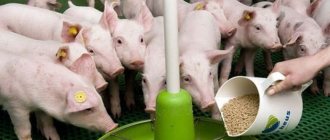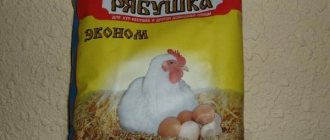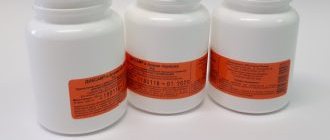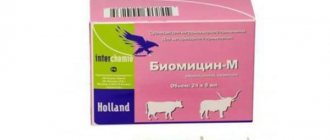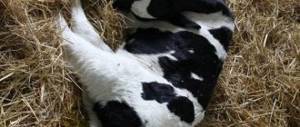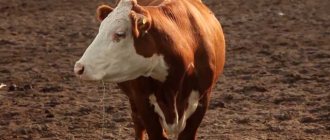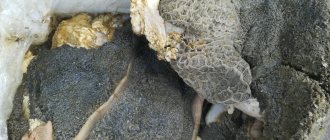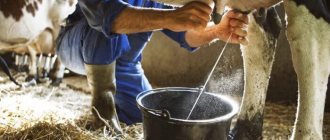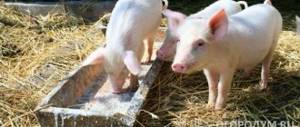What is milk replacer: what does it contain?
“Kormilak” is created from a mixture of delactose sweet whey, whey protein concentrate and lactose anhydride. Composition of milk replacer in percentage:
- 73-75% - dairy products (of which 29-30 are sweet whey, 18-20 - whey protein concentrate, 20-25 - delactose whey);
- 5% – mineral and vitamin supplements;
- 9-10% – vegetable protein mixture.
The concentrate, which has a valuable balanced amino acid composition, gives the product special value. Membrane technology makes it possible to obtain a concentrate by drying whey and “purifying” the product from excess minerals and lactose. Also, delactose whey should not be underestimated, since the digestion of newborn calves can only handle a limited amount of lactose.
About the benefits and profitability of powdered milk
Young animals growing in natural conditions are provided with a sufficient amount of mother's milk . With industrial cattle breeding there are no such opportunities. Feeding young livestock leads to an increase in financial costs and a decrease in sales volumes.
The nutritional value of the substitute is identical to natural milk; it contains additional substances that are better absorbed by the body . 1 kg of dry composition is cheaper than 1 liter of milk. This allows you to increase the period of feeding of animals, makes it affordable for small farms and reduces the cost of purchasing vitamin and mineral complexes.
Be sure to read:
How much and when does a cow give milk: average milk yield in liters
A ready-made highly nutritious mixture, made taking into account the physiology of the animal, contributes to its rapid development.
The composition of the substitute is adapted to cow's milk and is able to give young animals everything they need - this is its main advantage. In addition, the product contains pasteurized milk components, in which all infectious agents are destroyed.
Advantages and disadvantages
Many manufacturers offer whole milk substitutes for feeding calves. The mixtures are available in different compositions and types (dry powder, concentrated substance, liquid product). Positive qualities of the Kormilak milk replacer:
- the mixture does not contain antibiotics;
- the product is enriched with biologically active elements (vitamins, macro- and microelements);
- Easily digestible milk and vegetable proteins, animal and vegetable fats, and synthetic amino acids are used in production;
- the presence of special emulsifiers prevents the appearance of lumps;
- Additives and flavorings help increase appetite in calves;
- The shelf life of the food is 8 months.
The mixture does not show any clearly defined deficiencies. When diluting food, you must strictly adhere to the proportions specified by the manufacturer. Since violation of the norms can cause diarrhea in animals.
See also
Determining the service period for cows and how long the intercalving cycle lastsRead
What is CCM
The milk period in calves most often lasts 1-2 months. All this time they are actively gaining weight and need a lot of proteins. However, feeding calves with milk for such a long period is, of course, impractical. After all, this is the main product of almost any cattle breeding farm. Without it, the farmer will not be able to make a profit. In order to avoid financial losses, owners of such farms often use milk replacer for calves.
This food is a dry mixture of a special composition. Being diluted, the nutritional qualities of milk replacer are practically in no way inferior to ordinary milk.
Types and classification
Companies produce milk substitutes according to certain recipes. Depending on the percentage of substances in the product, the powders are intended for feeding calves of a certain age. Several types of Kormilak powder are produced according to the percentage of fat and protein (comparative table).
| View of "Kormilak" | Percentage of substances | |
| fats | squirrels | |
| No. 20 for calves from the 5th day of life | 20 | 22 |
| No. 16 for newborns from the 7th day of life | 16 | 22 |
| No. 12 for animals from the 21st day of life | 12 | 21 |
When choosing a specific type of substitute, you need to take into account its classification (relative to the age of the animals).
Rules for using milk replacer for calves: feeding standards
The period of milk feeding of young cattle is on average 17-20 weeks. During this time, the amount of liquid increases, and the proportions, accordingly, also change.
Breeders of pedigree livestock practice two feeding schemes:
- the first method is used when weaning a calf on the 14-21st day;
- The second method is applicable when milk feeding is stopped after 10 days.
At the same time, up to five weeks of age, 1 kg of milk replacer is fed per day, and after that its amount is reduced to 750 g/day.
| weeks | Volume, l | Dilution proportions | Peculiarities |
| 1-3 | 2,3 | 1:8 | 1100 g of dry mixture is equal to 10 liters of milk |
| 4-5 | 3 | ||
| 6 | 1:9 | ||
| 7-11 | 1:10 | ||
| 12-14 | CCM is gradually removed from the diet. Young animals are transferred to nutritious food | ||
Most manufacturers produce products that allow for a trouble-free transition to artificial feeding from one and a half weeks of age, subject to compliance with technological standards.
The nutritional value of the substitute is identical to natural milk; it contains additional substances that are better absorbed by the body.
If a calf was born from a sick mother and natural feeding is contraindicated for it, then the transition to artificial feed can be made 72 hours after its birth.
Depending on the breed, size and other nuances, one individual is capable of eating 28-42 kg of substitute.
We also have another article you should read: diet for feeding calves from 0 to 6 months.
How to choose a replacement product?
To choose a high-quality whole milk substitute, you need to take into account several factors: the biochemical composition of the product, the availability of feed for calves of different ages, the type of consistency, and cost. Manufacturers produce two types of substitutes for animal feeding:
- dry powder and concentrated mixtures (diluted with water in certain proportions);
- liquid food, ready to eat immediately.
Dry feed is most in demand, since the products are easier to store and have a long shelf life. A significant plus is that the composition of the feed matches the quality of cow's milk as closely as possible.
If you focus on the cost of the product, you need to take into account that cheap mixtures are of poor quality.
Unprocessed soy flour and other low-quality substances are added to substitutes. Such additives can cause diarrhea in animals, so they are not recommended for feeding calves.
In what cases is it used?
Despite the fact that milk replacer is widely used in agriculture, it is used only when necessary. This is due to the fact that sow milk cannot match the composition of even the best substitute. A whole milk substitute is given to piglets in the absence of a nursing sow.
If there are cows and goats in the farmyard, their milk is used for suckling piglets.
- CCM can also be used in the presence of cow's milk , since the mixture is much cheaper in cost and more stable, balanced for the body of piglets. All milk replacers contain a stable component, which is responsible for the constancy and uniformity of the mixture composition.
- The use of milk replacer is relevant for a large number of newborns . It is better to play it safe and introduce a substitute as additional nutrition from the first days of life.
- If piglets are taken away from their mother for various independent reasons. There are increased requirements for feeding weaners, especially in winter: the feed should have a high lactose content, a vitamin complex, and a concentration of carbohydrate fillers.
What to feed piglets in winter, read the link.
Features of artificially fed piglets
Artificial feeding is often used within the farmyard, which also includes growth supplements. Ideally, piglets should absorb at least colostrum from the sow so that their body receives the mother's antibodies, but sometimes from the first hours the owners have to nurse the cubs themselves.
Read about fattening piglets for meat in this article.
Newborns suckle every 1.5 hours, that is, at least 16-20 times a day, so they need to be fed milk replacer with the same frequency, even at night.
- the mixture is diluted in a more concentrated form, 1:5, and distilled water must be taken. Another special point: the dishes should always be clean, they are washed and doused with boiling water after each feeding;
- the one-time norm for one individual up to 3 days of age is no more than 40 g, if everything goes well, then it is gradually increased;
- It is important to observe not only the dosage, but also the feeding regimen. Animals quickly adapt to the schedule and behave more calmly, knowing at what time food will be brought to them;
- Small piglets, naturally, do not know how to lap, so until they are 10 days old, farmers drink from ordinary horns, through a nipple. Then gradual accustoming to the saucer and plate begins;
- The milk replacer temperature must be in the range of 37-40°. Too low can lead to inflammation, and too high to tract burns;
- when switching to starter feed, feedings are reduced to 10-12 times a day;
- In addition to the feeder with the mixture, there should always be troughs with clean water and a mixture of grass and hay in the stall.
The food is left for no more than 15-20 minutes, then it is removed regardless of whether the pig has eaten everything or not.
Read about how to make a feeder for a cow in this material.
How to dilute dry milk replacers?
Properly prepared milk replacer is better absorbed by the newborn's digestive system. The required part of the powder is first diluted with a small volume of hot water, and then a certain amount of liquid is gradually added so that there are no lumps in the finished mixture. Features of powder dilution:
- the mixture must be fresh, so it is prepared immediately before feeding the animals. The finished product must be fed within 8-10 minutes, since sediment will form later and the nutritional value of the whole milk substitute will decrease;
- the liquid is poured into cleanly washed containers so as not to provoke diarrhea;
- Cold dairy products should not be fed to calves. The mixture should be warm (optimal temperature – 35-38 °C).
See also
Instructions for use of Surfagon for cows, contraindications and analoguesRead
It is recommended to strictly adhere to the instructions from the food manufacturer. As a rule, the finished solution of dry powder should contain at least 12%.
In what proportions and how to dilute: instructions for cooking on the farm
On the packaging there is usually an instruction regulating the method of diluting the substitute, as well as the proportions. The mixture is prepared immediately before soldering, otherwise the composition loses its beneficial qualities.
Breeding Features:
- The utensils used for cooking must be thoroughly washed and scalded with boiling water or steamed.
- To dissolve, take a liquid heated to a temperature of +50…+60 0C:
- at lower rates, the substitute will fall to the bottom in the form of sediment;
- An increase in degrees will lead to the breakdown of protein and vitamins.
- The finished composition should not contain lumps. Therefore, restoration is carried out in several steps:
- take ½ of the total amount of water required for dilution;
- with gradual mixing, the entire required ration of milk replacer is added;
- The remaining liquid is added and the composition is brought to standard.
- Before feeding, the liquid is cooled to +37...+40 0C, which corresponds to the temperature of the milk in the udder.
- After dilution, the milk replacer can be used for mass feeding through an automated drinking system.
Be sure to read:
Feeding dairy cattle: daily allowances, diet, feed additives
Failure to comply with the proportions specified in the instructions can cause intestinal dysfunction and lead to undesirable consequences, including death.
What is the composition of milk replacer for calves?
The most common ingredients used in the manufacture of whole milk substitutes are:
- dry return;
- dry whey;
- vegetable and animal fats;
- grain shit;
- various kinds of vitamin and mineral supplements (premixes).
When preparing such mixtures, enterprises carefully monitor compliance with the proportions of the components. If the balance is imbalanced, milk replacer for calves, the price of which is not particularly high, will not correspond to the consistency of the milk. Consequently, its use as feed for young animals will not bring the desired effect. Of course, SES standards must also be observed when producing this food. Otherwise, the calves receiving it may become infected with some dangerous diseases.
